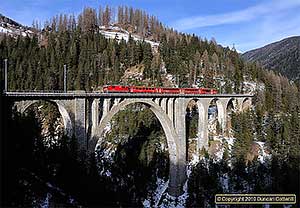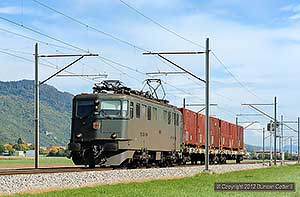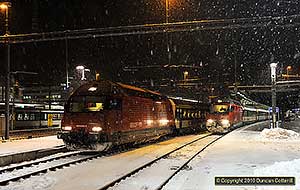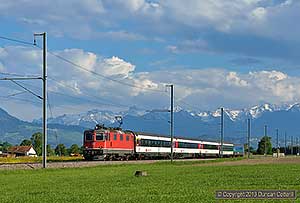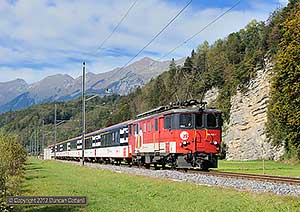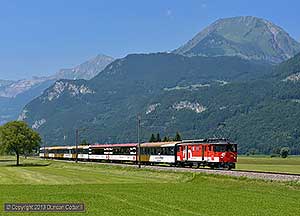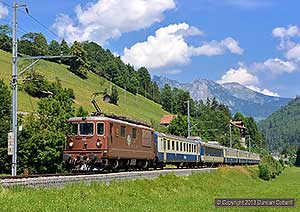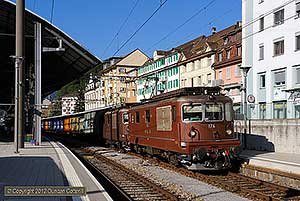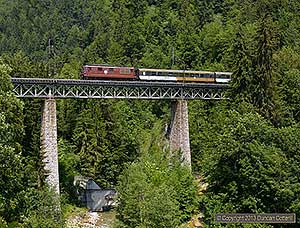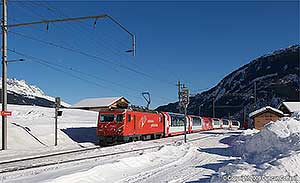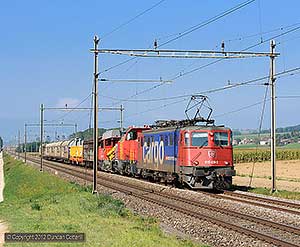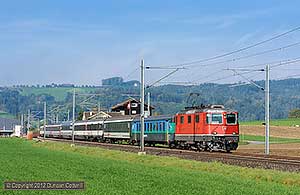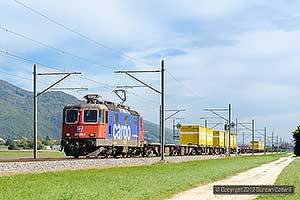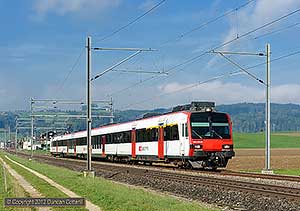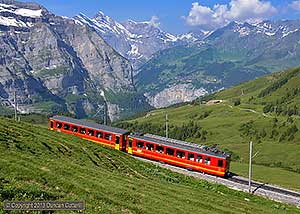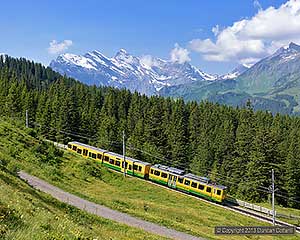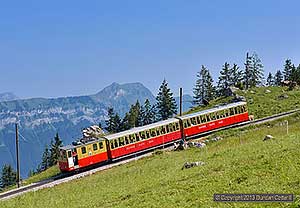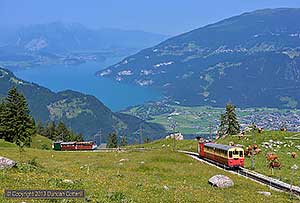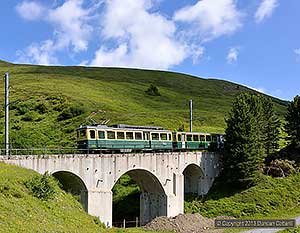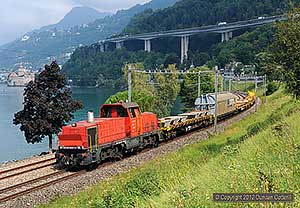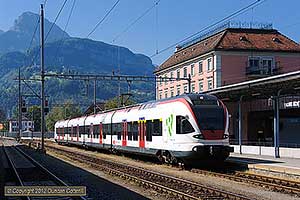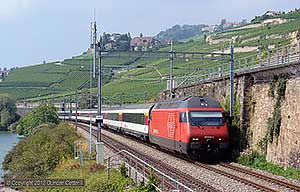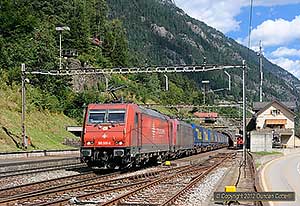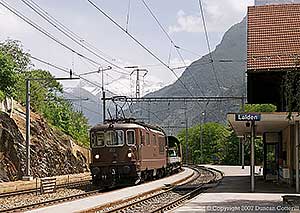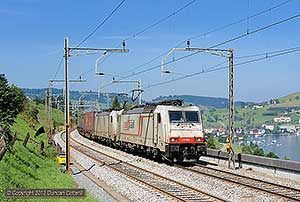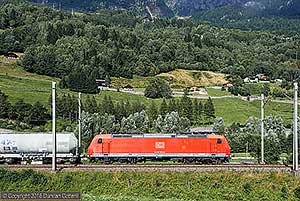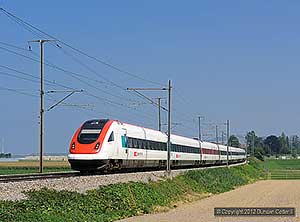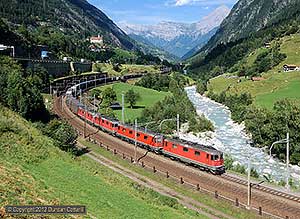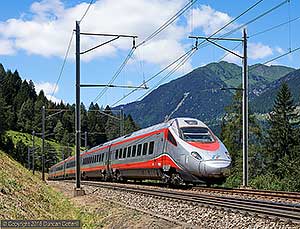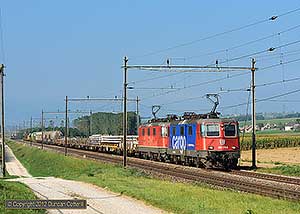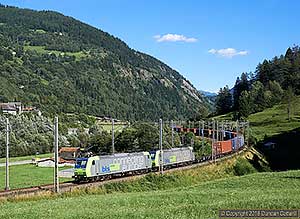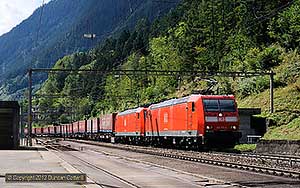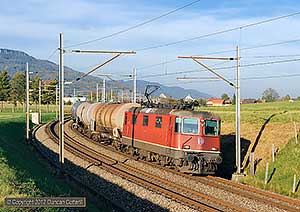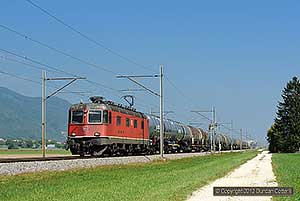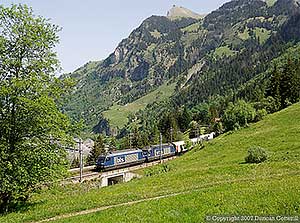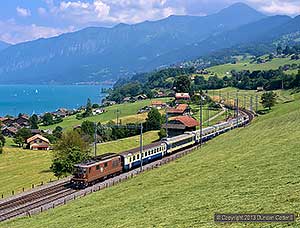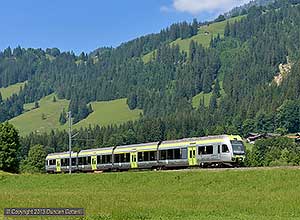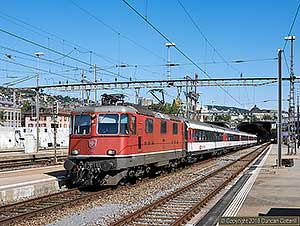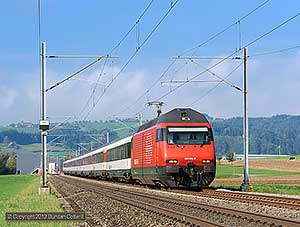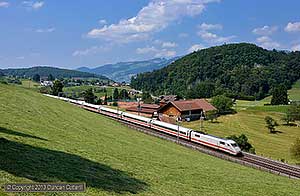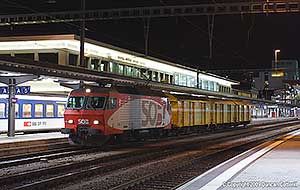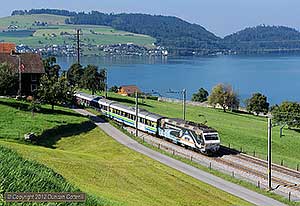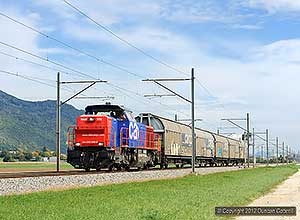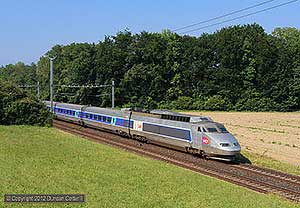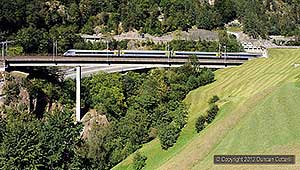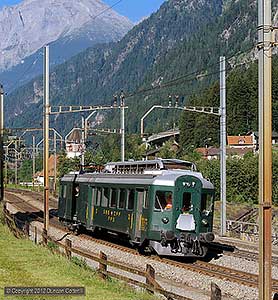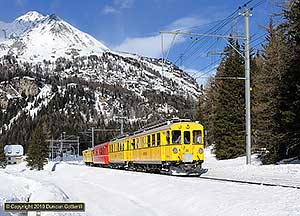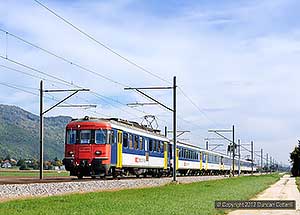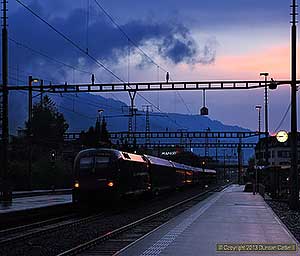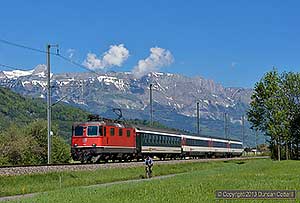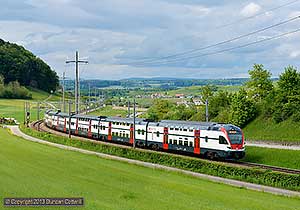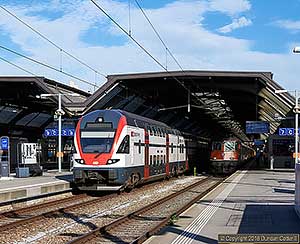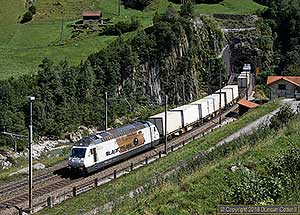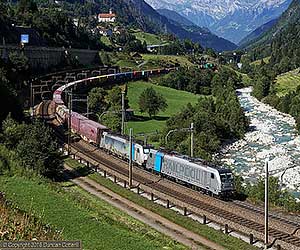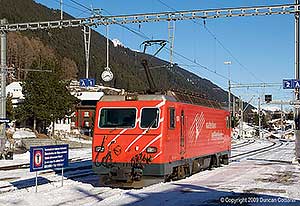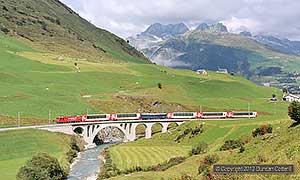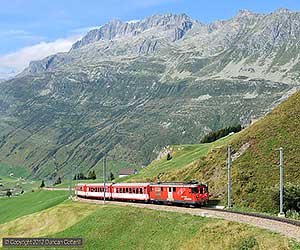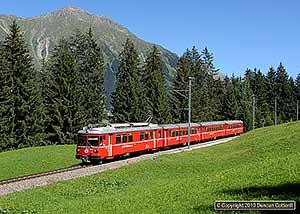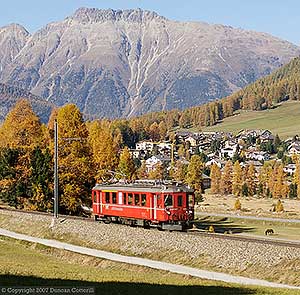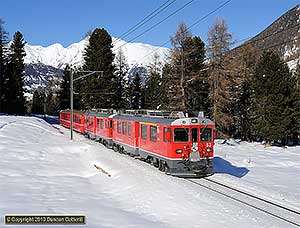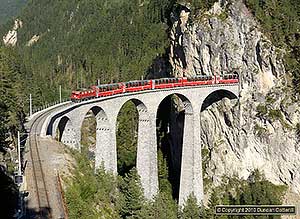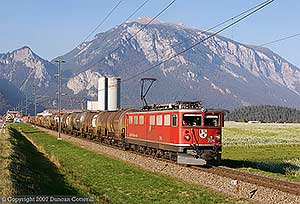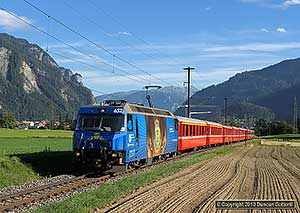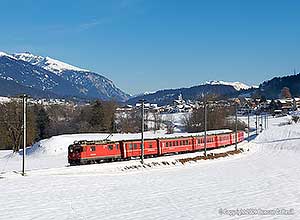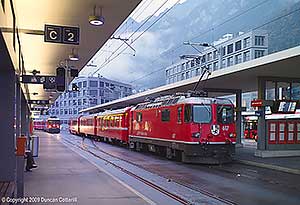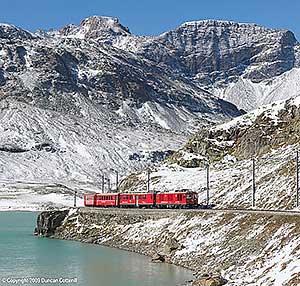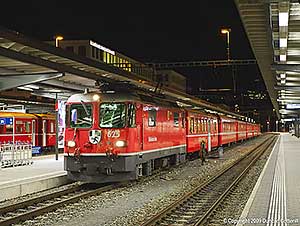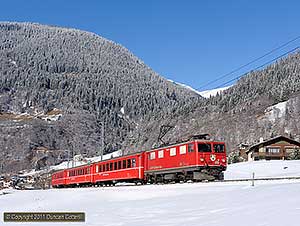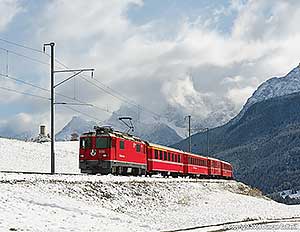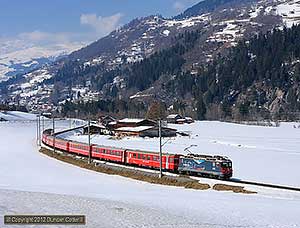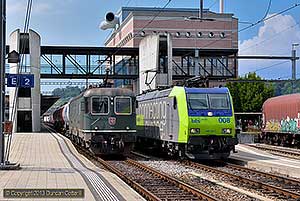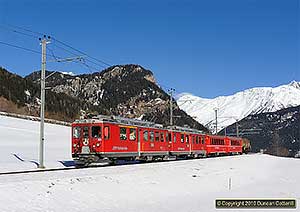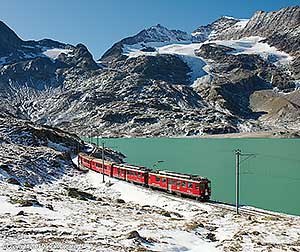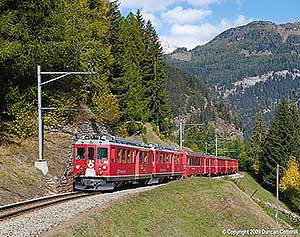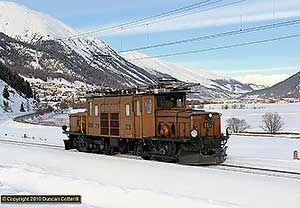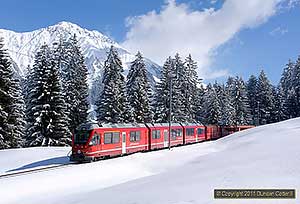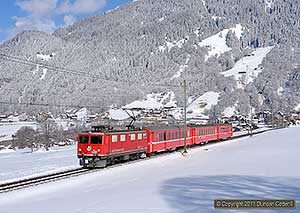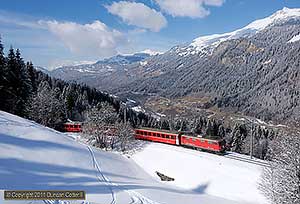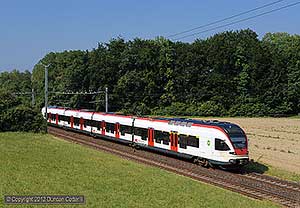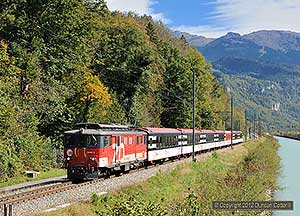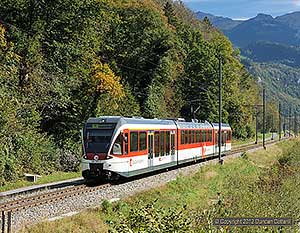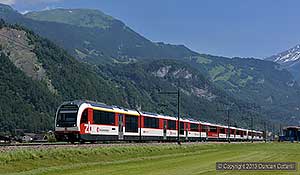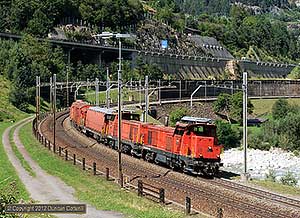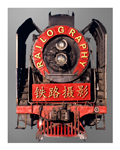915 RhB Davos - Filisur
14 photos
updated : 2016-07-21
This is one of the quieter lines on the RhB system but is not devoid of interest. From Filisur it follows the Landwasser river east through deeply incised gorges until the valley widens on the approach to Davos. The line has seen a variety of traction over the years, including Ge4/4i, Ge4/4ii and Ge4/4iii class locos.
Class Ae610
11 photos
updated : 2016-07-21
The classic Ae6/6 Co-Co electrics were introduced in 1955 and remained in service with SBB Cargo until late 2012. A few enjoyed a brief revival in 2013 but have since been withdrawn. Originally designed for working the Gotthard route, they ended their days in the flatter parts of northern and western Switzerland.
900 Zürich - Chur
4 photos
updated : 2016-07-21
Chur is the largest town in Graubunden and is linked to Zürich by a double track electrified line running via Sargans, the junction for trains to Austria and north-east Switzerland. The line sees frequent passenger services and some freight traffic, including Austrian Railjets and international freight west of Sargans.
880 Sargans - St Gallen
5 photos
updated : 2016-07-21
The Chur - Sargans - St.Gallen route is a secondary line connecting the two most important centres in the east of Switzerland. It's not particularly busy but it did have loco hauled passengers as late as 2013 and there were some very attractive mountain backgrounds, especially around Sevelen.
ZB Class De110
12 photos
updated : 2016-07-21
The De110 motor luggage vans were introduced in 1941 as Deh4/6 with rack gear and worked through services for decades. They were rebuilt from 1986 as adhesion only and used on local trains but returned to express duty on the Interlaken - Meiringen section for their last few years until withdrawal in 2013.
470 Interlaken - Luzern
17 photos
updated : 2016-07-21
The Interlaken - Luzern line, also known as the Brünigbahn, is a metre gauge line with rack sections but, like the MGB and RhB, has a main line character. Until late 2013 most IR services were worked by locomotives north of Meiringen and 1940s built motor luggage vans between there and Interlaken.
320 Spiez - Zweisimmen
10 photos
updated : 2016-07-21
The Spiez - Zweisimmen line is a standard gauge electrified branch operated by BLS and connecting the Lötschberg main line with the northern end of the MOB metre gauge line to Montreux. Most trains are worked by EMUs but there were a handful of loco hauled workings as well in 2013.
Class Re425 (BLS Re4/4)
13 photos
updated : 2016-07-21
Class 425 are the BLS Re4/4 locos, roughly equivalent to the SBB Re4/4ii but slightly more powerful. A total of 35 were built between 1964 and 1983 and some are still in service today with BLS on car shuttles. The last passenger duties for the Class 425s were on the Interlaken - Zweisimmen route in 2013.
BLS
15 photos
updated : 2016-07-21
BLS passenger operations are centred on Bern and the company operates most local services in Canton Bern as well as longer distance routes east to Luzern, west to Neuchatel and to Brig via the Lötschberg line. Most services are operated by EMUs but there were still a few loco hauled trains until recently.
142-143 MGB Disentis - Visp
12 photos
updated : 2016-07-21
The Matterhorn Gotthard Bahn was formed by the merger of the Brig Visp Zermatt and Furka Oberalp railways in 2003 and runs from Zermatt to meet the RhB at Disentis. The route goes via Visp, Brig, the Furka base tunnel and the Oberalp Pass (No prizes for guessing where its predecessors got their names).
210 Lausanne - Biel/Bienne
15 photos
updated : 2016-07-21
The Lausanne - Biel/Bienne line is the southern part of the main route linking Basel and Zürich with Lausanne and Genève. Passenger traffic is almost entirely worked by units but there's a healthy level of freight traffic and a number of trains were regularly hauled by Ae6/6s in late 2012.
510 Olten - Luzern
11 photos
updated : 2016-07-21
The Olten - Luzern line runs through pleasant countryside and was one of the last lines where Ae6/6s worked freight, making it a must for a visit in the summer of 2012 when the class was living on borrowed time. There were plenty of other loco hauled trains and units around as well.
410 Biel/Bienne - Olten
28 photos
updated : 2016-07-21
This is the northern end of the Jurafuss route, linking Basel and Zürich with Lausanne and Genève via Neuchatel and Biel. Units work most passengers but freight traffic is quite heavy with oil tanks and postal trains predominating. A few freights were still worked by class Ae6/6 locos in late 2012.
Class RBDe560 - 562, 565 - 568
9 photos
updated : 2016-07-21
These classes are, strictly speaking, single ended motor coaches dating from the 1980s that operate with varying numbers of trailers, not necessarily of a matching design. They can be found on local services operated by SBB and several independent operators, including BLS.
311-312 Jungfraubahn
4 photos
updated : 2016-07-21
The Jungfraubahn operates the highest railway in Europe, starting at Kleine Scheidegg, 2061m above sea level and terminating 3454m asl at Jungfraujoch. It's a metre gauge rack line and one of the few railways to still use a 3-phase electrification system to power its EMUs and motor coaches.
311-312 Wengeralpbahn
5 photos
updated : 2016-07-21
The Wengernalpbahn operates two short 800mm gauge, 1500V DC, rack lines in the Bernese Oberland, linking Lauterbrunnen and Grindelwald with Kleine Scheidegg, where they connect with the Jungfraubahn. Motive power is entirely EMUs and motor coaches, some of them dating from the 1940s.
SPB Class He2/2
4 photos
updated : 2016-07-21
These 4-wheel, 800mm gauge, 1500V DC rack electrics are all now over 100 years old but around 9 are still in daily service from May to October each year. They operate all regular services on the Schynige Platte Bahn, a mountain railway close to Interlaken in the Bernese Oberland.
314 Schynige Platte Bahn
4 photos
updated : 2016-07-21
The Schynige Platte Bahn is a short, 800mm gauge mountain railway in the Bernese Oberland, electrified at 1500V DC. The line climbs from Wilderswil, close to Interlaken, to Schynige Platte, 1967m above sea level, and is operated by ancient 4-wheel electric rack locos, all of them now over 100 years old.
Narrow Gauge
9 photos
updated : 2016-07-21
This gallery covers railways with a gauge of less than 1 metre, of which Switzerland has several. Most of these are 800mm gauge rack-equipped mountain railways. At the moment only the Schynige Platte and Wengernalp lines are featured, both mountain railways in the Bernese Oberland.
Diesel Locos
5 photos
updated : 2016-08-25
Switzerland is well known for its electric railways but there are still sidings and short branches that aren't wired and trains occasionally have to be rescued when the power fails. As a result, there is a requirement for diesel locos but nothing particularly impressive. Tunnel firefighting trains are also diesel worked.
Class RABe521 - 524, 526 - 528
6 photos
updated : 2016-08-25
Classes 521 to 524 are Stadler Flirt EMUs in service with SBB. The basic units are Class 523 with classes 521, 522, 524 fitted for cross-border work to Germany, France and Italy respectively. All are 4-car except for 11 6-car Class 524. Classes 526 to 528 are used by SOB, TRN and BLS respectively.
100 Lausanne - Brig
7 photos
updated : 2016-09-04
This scenic line runs alongside Lake Geneva from Lausanne to Villeneuve then follows the Rhone Valley to Brig in the heart of the Alps. The line carries both domestic and international traffic, including a half-hourly loco-hauled passenger service, EMUs on local trains and a fair amount of freight.
Crossrail
6 photos
updated : 2016-09-04
CrossRail specialised in long distance transit freight between Belgium and Italy via the Lötschberg and Gotthard routes using a fleet of German registered Bombardier Traxx electrics. Crossrail ceased operating in Switzerland in 2017 and its Belgian operations were acquired by BLS Cargo in 2019.
300 BLS Lötschberg Line
15 photos
updated : 2016-09-04
The Lötschberg main line is a busy freight and passenger route across the Swiss Alps. As well as being a major trunk route, it’s a scenic delight and a real engineering marvel. These pictures were taken in the last weeks before the opening of the base tunnel bypassing the most scenic sections of the line.
Class Re484, 486
5 photos
updated : 2016-09-04
SBB Class 484 and BLS Class 486 are Bombardier Traxx MS multi-system electrics, capable of working from 3000V DC in Italy as well as 15kV AC in Switzerland (and, in the case of the 486s, Germany as well). German registered class 186s are also Traxx MS and are included here.
DB Cargo
6 photos
updated : 2016-09-04
DB Cargo operates freight trains in Switzerland using a fleet of class 185 (Bombardier Traxx) electrics fitted with Swiss pantographs and signalling equipment. Since these pictures were taken, DB has dissolved its partnership with BLS and now operates its trains in conjunction with SBB.
Class RABDe500
8 photos
updated : 2016-09-04
The SBB Class 500 tilting InterCity EMUs, also known as ICN units, are used on internal long distance services, mainly between Geneve or Lausanne and Basel or St.Gallen. They were used between Basel or Zürich and Lugano. The 44 7-car units are 15kV only and don't venture outside Switzerland.
600 Gotthardbahn
96 photos
updated : 2016-09-04
The Gotthardbahn combined the superb scenery of the Swiss Alps with heavy passenger and freight traffic, making it a prime target for photography. The Gotthard Base Tunnel opened in 2016, since when the mountain route has seen few freights or loco hauled passenger trains.
Class RABe503 (ETR610)
9 photos
updated : 2016-09-04
The ETR610 tilting EMU is a dual system version of the Italian ETR600, operated by SBB and Trenitalia on cross-border services. SBB class them as RABe503 but they all carry numbers in the Italian 610 series. Some can be found on domestic Swiss ICNs between Basel or Zürich and Lugano.
SBB Cargo
63 photos
updated : 2016-09-04
SBB Cargo is the freight arm of Switzerland's national operator, split off in 1999, and operates the wagonload and block trains in Switzerland and abroad. Many trains are still operated by 1960s vintage locos of classes Re4/4ii (420) and Re6/6 (620) with SBBC's more modern locos being used abroad.
BLS Cargo
13 photos
updated : 2016-09-04
BLS Cargo has evolved into an international freight operator, handling block trains all over Switzerland and into neighbouring countries. It still rosters Class 425 and 465 electrics at home but also has a number of modern multi-system Traxx and Vectron locos for international services.
Class Re482, 485
12 photos
updated : 2016-09-04
The BLS Class 485 locos and SBB Class 482s are Bombardier Traxx F140AC dual system electrics, equipped for operation from 15kV and 25kV AC systems, like the German Class 185s, which are also included here. They are most common on freights from Germany to the Swiss/Italian border.
Class Re420, 421, 430, 436
80 photos
updated : 2022-09-05
These are all minor variants of the classic SBB Re4/4ii design dating from 1964 and in series production from 1967 to 1985. All 302 locos had traditional tapchanger control and single phase AC motors. Many are still in service with SBB but withdrawals have begun. Other operators have a few locos.
Class Re620
31 photos
updated : 2022-09-05
The SBB Re6/6 is effectively a larger version of the Re4/4ii with a Bo-Bo-Bo wheel arrangement but can deliver 10,700hp, well over 50% more power than its smaller cousin. A total of 89 were built between 1972 and 1980 and most remain in service with SBB Cargo although withdrawals have begun.
Class Re465
3 photos
updated : 2022-09-05
BLS Class 465 15kV Bo-Bo electrics are similar to the SBB Class 460s but are more powerful have a better anti-wheelslip system. A total of 18 were built in the late 1990s. They are primarily used by BLS Cargo for freight traffic, not only on the Lötschberg but elsewhere in Switzerland as well.
310 Interlaken - Spiez
9 photos
updated : 2022-09-05
The Spiez - Interlaken line is less than 20km long and is unphotographable for much of its length, running alongside a main road and squeezed into a narrow strip between the lake and forested hills. However, one of the few good shots on the line is the classic position at Faulensee, overlooking the Thunersee.
Class RABe525, 535
4 photos
updated : 2022-09-05
Classes 525 and 535 are articulated EMUs built for BLS by Bombardier. The Class 525 "Nina" was introduced in 3-car sets for local services in 1998, with several later extended to 4-cars. Class 535 "Lötschberger" 4-car units followed for longer distance routes in 2008. Both types are used across the BLS network.
800 Zürich Area
7 photos
updated : 2022-09-06
Zürich is a major hub on the Swiss rail network, with regular passenger trains to all parts of the country and a large freight yard, RB Limmattal, west of the city. Zürich HB is the city's main station, where classic Re4/4iis and 460s mix with various EMUs, German ICEs, French TGVs and Austrian Railjets.
Class Re460
24 photos
updated : 2022-09-06
SBB acquired a total of 119 powerful Class 460 15kV Bo-Bo electrics between 1991 and 1996, equipped with inverter driven 3-phase motors and capable of 200km/h, They all work passenger trains for SBB, usually paired with double deck push-pull sets. Many were with the freight sector until 2003.
DB Class 401
1 photo
updated : 2022-09-06
DB Class 401 units were introduced in 1989 and were the original ICE high speed EMUs, capable of 280km/h and usually formed of two power cars and 12 trailers. The class regularly visits Switzerland on through services from Germany routed via Basel. Swiss destinations include Interlaken.
DB
1 photo
updated : 2022-09-06
DB or Deutsche Bahn, is Germany's state railway and operates passenger and freight trains across Germany. DB co-operates with SBB on through passenger services between the two countries, with DB stock working well into Switzerland and vice-versa. DB uses Class 401 ICEs on most services.
Class Re446, 456
3 photos
updated : 2022-09-06
Class 446 started life as SBB Re4/4iv thyristor control prototypes but didn't go into series production. The 4 locos were sold to SOB. Class 456 is similar to the 446 in appearance but the 14 locos have 3-phase drive. SZU uses its 456s on passengers, the remaining 456s and the 446s are with independent operators.
SOB
4 photos
updated : 2022-09-06
SOB has expanded from operating the Arth-Goldau to Rapperswil route, plus a couple of branches, to running the whole Voralpen express route from Luzern to Romanshorn and, more recently, Inter-Regio services from Basel and Zürich over the Gotthard to Locarno. All SOB services are now worked by EMUs.
Class Am841 - 843, 845, 203, Bm840
5 photos
updated : 2022-09-06
Classes 840 to 843 and 203 are single-cab Bo-Bo diesel locomotives of various designs used for shunting, trip working and tunnel fire-fighting trains by SBB and SBB Cargo. Although the network is electrified, there is still a requirement for locos that can work unelectrified sidings or on lines where the power is off.
SNCF TGVs
1 photo
updated : 2022-09-06
TGVs have operate on several routes between Paris and Swiss destinations, including Basel, Genève, Lausanne and Zürich. The first services started in 1984 and various classes of TGV have been used since, including some equipped to use Swiss 15kV AC. The earliest sets have already been withdrawn.
SNCF
1 photo
updated : 2022-09-06
SNCF, the French national operator, runs passenger trains over the border to Basel SBB and Genéve Cornavin but the only services to travel further are the through TGVs between Paris and Zürich or Lausanne. BB37000 work freights to Muttenz (Basel) and Lausanne Triage yards but rarely any further.
FS Class ETR470
1 photo
updated : 2022-09-06
The ETR470 was a tilting EMU based on the Italian ETR460 but equipped to operate from Swiss 15kV AC in addition to Italian 3000V DC. The units were used on international services between Milan and Genéve, Basel and Zürich. They were unreliable and expensive to operate and withdrawn in 2014.
SBB Historic
1 photo
updated : 2022-09-06
SBB Historic owns and maintains a number of historic locos and items of rolling stock. It's fleet includes examples of many different classes of steam and electric locos and motor coaches dating back over a century. Many locos are kept in working order for use on special trains across the Swiss network.
Preserved
4 photos
updated : 2022-09-06
The Swiss are enthusiastic about railways and many locomotives and other items of rolling stock are retained by railways after their normal withdrawal dates or preserved by private individuals or preservation groups. Some locos are kept in working order for special trains or regular excursions.
Class RBe540
2 photos
updated : 2022-09-06
The Class 540 motor coaches were introduced in 1959 for use on fast trains in the flatter parts of Switzerland. They would normally operate with a few trailers and a driving trailer or sometimes with up to six trailers sandwiched between a pair of 540s. The last Class 540s were withdrawn in 2016.
ÖBB
1 photo
updated : 2022-09-07
ÖBB is the Austrian national operator. Its trains have run from the border station of Buchs to Zürich, sometimes to Basel, for many years. The 4010 sets of the 1960s and 1970s and the current Railjets have brought ÖBB motive power to Swiss rails. Conventional passengers and freights usually change locos at Buchs.
ÖBB Class 1116
1 photo
updated : 2022-09-07
The most common locomotives in Austria these days are Siemens Taurus Bo-Bo electrics of class 1116. ÖBB has around 280 in total, divided between its passenger and freight operations. They work most traffic as far as the Swiss border and stay on Railjet sets all the way to Zürich.
SBB
96 photos
updated : 2022-09-07
SBB operates passenger trains on the Swiss standard gauge network, with a few exceptions. Many long distance trains are still loco hauled but EMUs are rapidly taking over. Older locos and traditional stock can still be found on a few trains. Local services are mainly operated by EMUs.
760 Zürich - Schaffhausen
1 photo
updated : 2022-09-07
The Schaffhausen line runs north from Zürich, past the airport and through a succession of small towns and villages to cross the Rhein at Eglisau before reaching Schaffhausen. As well as SBB fast and local services, the line carries international passenger trains to Singen and Stuttgart and some freight.
Class RABe511
2 photos
updated : 2022-09-07
The Stadler built Class 511 double deck EMUs were introduced in 2011 and come in two versions, one for S-Bahn services around Zürich and the other for medium distance trains. The S-Bahn sets are all 6-car units but the medium distance variant also comes in a 4-car version. A total of 93 sets are in service.
railCare
1 photo
updated : 2022-09-07
railCare is a Swiss open access freight operator owned by the Coop. It operates intermodal trains on a number of routes connecting most parts of Switzerland with its Schafisheim hub, near Lenzburg. For several years the company used BLS Class 465s on its trains but now has 7 Class 476 Vectrons.
Railpool
1 photo
updated : 2022-09-07
Railpool is one of the larger German locomotive leasing companies with a fleet of modern Bombardier TRAXX and Siemens Vectron locomotives equipped for operation over much of the European network. Many of its locos carry a silver and blue livery but others are painted in the colours of their operators.
Class 187 (DE)
1 photo
updated : 2022-09-07
The AC3 version of the Bombardier Traxx electric doesn't have a Swiss class number so the German classification will have to suffice. Class 187s are used by various open access freight operators on freights to or through Switzerland and are an improved version of the German Classes 145, 186, 185 and 186.
TrenItalia
6 photos
updated : 2022-09-07
TrenItalia is the Itailan national operator, previously known as FS. SBB and FS have co-operated on passenger services between Switzerland and Italy for many years and operate a jointly owned fleet of Class ETR610 / RABe 503 tilting EMUs on services from Milan to Zürich and Basel.
MGB Class HGe4/4ii / ZB Cl 101
9 photos
updated : 2022-09-08
These 2600hp metre-gauge rack and adhesion Bo-Bo electrics were built for the ZB's and MGB's predecessors in 1985-90 and differ mainly in operating voltage and rack systems, 11kV and Abt for MGB and 15kV and Riggenbach for ZB. They usually work passenger services on their respective lines.
MGB
12 photos
updated : 2022-09-08
The Furka Oberalp and Brig Visp Zermatt railways merged to form the Matterhorn Gotthard Bahn in 2003. Both lines are metre gauge, electrified at 11kV 16.67Hz AC and have rack sections in places. The main line from Zermatt to Disentis is 141km long and the branch from Andermatt to Göschenen is 4km.
MGB Class Deh4/4
5 photos
updated : 2022-09-08
This gallery covers 3 classes of metre-gauge, 11kV AC, rack and adhesion motor luggage vans. Classes Deh4/4, Deh4/4i and Deh4/4ii were built for the predecessors of the MGB in 1972-79. Of the 15 built, the 4 Deh4/4 are slated for early withdrawal but the others are due to be modernised.
RhB Class Be4/4
5 photos
updated : 2022-09-08
The Be4/4 motor coaches were primarily used on suburban services around Chur and Landquart but could operate anywhere on the RhB's 11kV network. They were displaced from their usual suburban duties by new ABe4/16 units a few years ago but some remained available for use until late 2021.
RhB Class ABe4/4
1 photo
updated : 2022-09-08
Four Class ABe4/4 motor coaches were introduced in 1939 for use on fast services to St Moritz and Davos but soon proved inadequate to meet the demand. They were relegated to lesser duties for the rest of their lives and withdrawn in 1999. One motor coach has been retained for special trains.
RhB class ABe4/4iii
12 photos
updated : 2022-09-09
The six ABe4/4iii were built for the Berninabahn between 1988 and 1990 and are similar to the ABe4/4ii in appearance but quite different technically, with 3-phase AC drives. They are still in service but now carry advertising liveries which detract greatly from their appearance.
940 RhB Chur - St Moritz
113 photos
updated : 2022-09-09
The Albula route is the Rhätischebahn’s principal main line and links Chur with St Moritz. Trains climb to a summit 1823m above sea level in the 5.8km Albula Tunnel that gives access to the Oberengadin. The route includes the famous Landwasser viaduct and a series of spirals above Bergün.
RhB Class Ge6/6ii
44 photos
updated : 2022-09-09
The seven Ge6/6ii Bo-Bo-Bos were the RhB's principal freight locomotives, operating most freights on the 11kV network and often used on passenger trains as well. They were built between 1958 and 1965 and remained in service until late 2021 when the remaining locos were withdrawn.
RhB Class Ge4/4iii
69 photos
updated : 2022-09-09
The Ge4/4iii are the RhB's most powerful locomotives and operate most passenger services on the Chur - St.Moritz route and the car shuttles through the Vereina Tunnel. They do also appear elsewhere on the 11kV network on passenger services and on freight. Most carry advertising liveries.
920 Chur - Disentis
51 photos
updated : 2022-09-09
From Reichenau-Tamins the line follows the Vorderrhein valley west to Disentis / Muster where it makes an end on connection with the former FO (now MGB) metre gauge line to Andermatt and Brig. Traffic is fairly heavy with Glacier Express and freight trains in addition to the regular passengers.
930 Chur - Arosa
2 photos
updated : 2022-09-09
The Arosa line runs 25km into the mountains south of Chur, climbing 1155m to the resort of Arosa. It is largely a self contained operation, running from its own platforms on Chur station forecourt with a connection across the standard gauge line east of the station to allow the transfer of rolling stock.
RhB Class Gem4/4
2 photos
updated : 2022-09-09
The RhB's two Gem4/4 electro-diesels were built in 1966 for use on the 1000V DC Berninabahn, although they can run anywhere on the system under diesel power. They can also supply power to one of the Xrote rotary snow ploughs used on the Berninabahn and can run in multiple with the line's motor coaches.
RhB Class Ge4/4ii
63 photos
updated : 2022-09-09
The 23 Ge4/4ii 11kV Bo-Bo electrics form the RhB's largest class and were delivered in two batches in 1973 and 1984. They're modern locos with thyristor control and DC traction motors and can be seen all over the main 11kV network, the Stammnetz, on passenger and freight trains.
RhB Class Ge4/4i
73 photos
updated : 2022-09-09
The first four Ge4/4i Bo-Bos were built for the RhB's 11kV network in 1947 with six more following in 1953. They were extensively rebuilt in the late 1980s but retained tapchanger control. The class was scheduled for withdrawal in 2012 but four locos have been retained for specials and other ad-hoc workings.
960 RhB Pontresina - Scuol-Tarasp
43 photos
updated : 2022-09-09
This line serves the Engadin or the En Valley. From Pontresina in the Upper Engadin, a broad, alpine valley flanked by high peaks and popular with tourists, the railway continues 57km north-east to Scuol-Tarasp, deep in the Lower Engadin and 500m lower, a much remoter area but no less scenic.
Loco Hauled Passengers
308 photos
updated : 2022-09-09
Locomotive hauled passenger trains are still reasonably common in Switzerland although multiple units are steadily making inroads. In addition to InterCity and other long distance trains, there are also loco hauled passengers on several metre gauge lines and at least one narrow gauge rack line.
Electric Locos
424 photos
updated : 2022-09-09
There's very little of Switzerland's railway system that isn't electrified and electric locos can still be found on many passenger services as well as freight. Many different types of electric loco can be seen, Swiss and foreign owned, private and state owned, standard and narrow gauge.
RhB class ABe4/4ii
26 photos
updated : 2022-09-09
Nine ABe4/4ii motor coaches were built for the Berninabahn between 1964 and 1972 and handled most services on the line until 2010, usually working in pairs hauling a number of coaches. The arrival of the ABe4/12s in 2010 rendered them surplus to requirements apart from three retained for departmental use.
950 RhB St Moritz - Tirano
42 photos
updated : 2022-09-09
The Berninabahn links St. Moritz with Tirano, just across the border in Italy and has a character of its own. It retains the original 1000V DC power supply and climbs on gradients as steep as 1 in 14 to a summit 2253m above sea level, the highest crossing of the Alps by a conventional adhesion only railway.
Motor Coaches
77 photos
updated : 2022-09-09
Swiss railways have traditionally used motor coaches and trailers instead of proper EMUs but that has changed in recent years and multiple units are now in fashion. The motor coach category includes the motor luggage vans used by the MGB and ZB, which are locomotives in all but name.
RhB Class Ge6/6i
1 photo
updated : 2022-09-10
The Ge6/6i Class were rod drive C-C electric locos introduced in 1921 to work on the newly electrified Albula line with more built later in the decade. Initially they worked all types of trains but were relegated to less demanding duties from the 1950s with most withdrawn in the 1980s. Two are kept in working order.
RhB Class ABe4/4i
2 photos
updated : 2022-09-10
These motor coaches were originally built in 1908-11 for the electrification of the Berninabahn and rebuilt in 1946-53. They were made redundant when the ABe4/4iii arrived in the late 1980s but two have been retained for special trains and another three were kept for departmental use until 2016.
RhB Class ABe8/12
9 photos
updated : 2022-09-10
Introduced in 2010, The ABe8/12 EMUs took over services on the Chur- Arosa line and most trains on the Bernina and later between Landquart, Davos and Filisur. These dual voltage units are more powerful than anything else on the RhB and can sometimes be seen working freights.
910 RhB Chur - Davos
46 photos
updated : 2022-09-10
The Landquart - Davos line runs through the Prättigau, the valley of the Landquart River. It connects the resorts of Klosters and Davos to the SBB at Landquart and connects to the Unterengadin via the Vereina Tunnel. The line isn’t as spectacular as the Albula route but does have some very pleasant locations.
RhB Rhätischebahn
302 photos
updated : 2022-09-10
The Rhätischebahn operates a large electrified metre gauge system in the Canton of Graubünden. Its lines run through spectacular Alpine scenery, linking upmarket resorts to the SBB system at Landquart and Chur. Most passenger trains are still locomotive hauled and there is some freight traffic.
EMUs
49 photos
updated : 2022-09-10
Switzerland's railways traditionally used motor coaches coupled to trailers in preference to EMUs but that has now changed and multiple units are rapidly taking over the operation of all types of passenger train, from suburban and local workings to InterCity and international expresses.
ZB Zentralbahn
17 photos
updated : 2022-09-11
The Zentralbahn was formed from the merger of the SBB owned 74km long Brünigbahn and the 34km Luzern-Stans-Engelberg Bahn in 2005. Both railways are metre-gauge with some rack sections and share the same line for the first 9km from Luzern to Hergiswil, where they split. .
ZB Class ABe130
2 photos
updated : 2022-09-11
The ZB Class ABe130 is a 3-section articulated EMU of the Stadler SPATZ model introduced in 2004 and developed from the MGB BDSeh4/8 EMU. The 10 ZB units are adhesion only and used on local services on the flatter sections of the Brünigbahn, specifically Meiringen - Interlaken and Luzern - Giswil.
ZB Class ABeh150, 160, 161
2 photos
updated : 2022-09-11
These 3 very similar designs of rack and adhesion EMU were built by Stadler for IR services from Luzern to Interlaken and introduced in 2012. The 160 and 161 are almost identical 3 car articulated units, while the 160 consists of two articulated but single ended 3-car units sandwiching an unpowered bistro car.
SBB Infrastruktur
2 photos
updated : 2022-09-11
SBB Infrastruktur is responsible for the SBB network, from timetabling trains and controlling movements to maintaining the bridges, tunnels and permanent way and managing new construction. The company employs a number of diesel locos on engineering and tunnel fire fighting trains.
Switzerland is famed the world over for its beautiful alpine scenery and its excellent, punctual and well connected transport system. The railways are a real delight with a huge variety of gauges, railway companies, locomotives and liveries all running through the picturesque Swiss landscape.




 options
options hide options panel
hide options panel